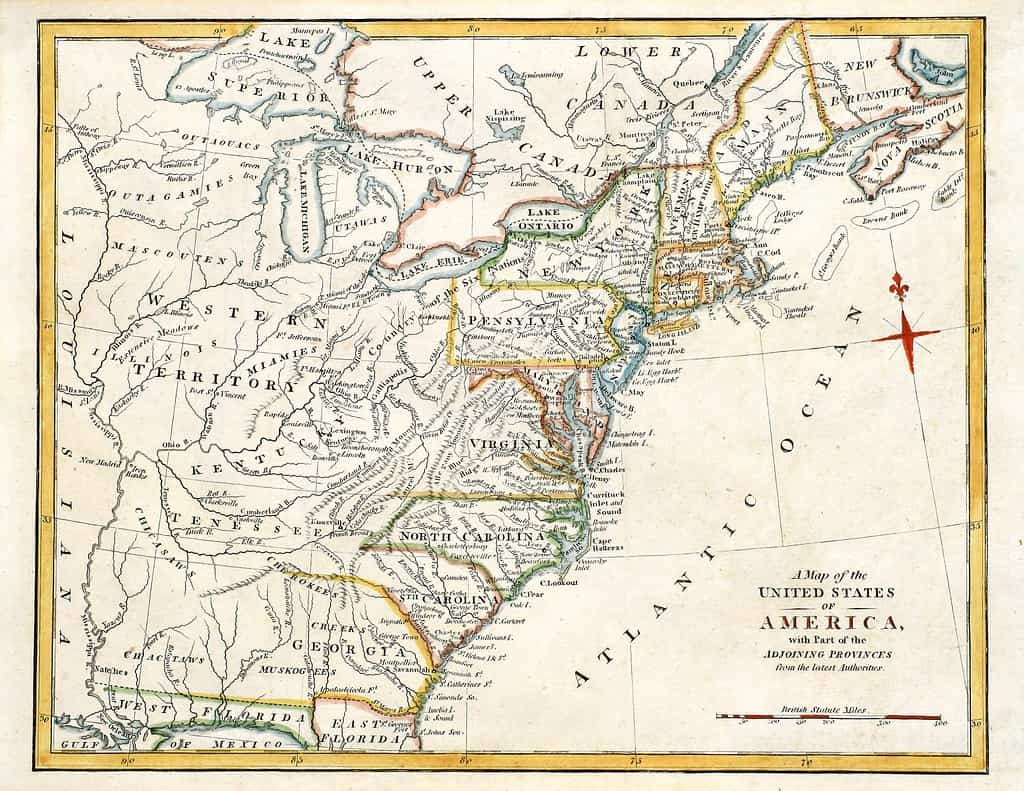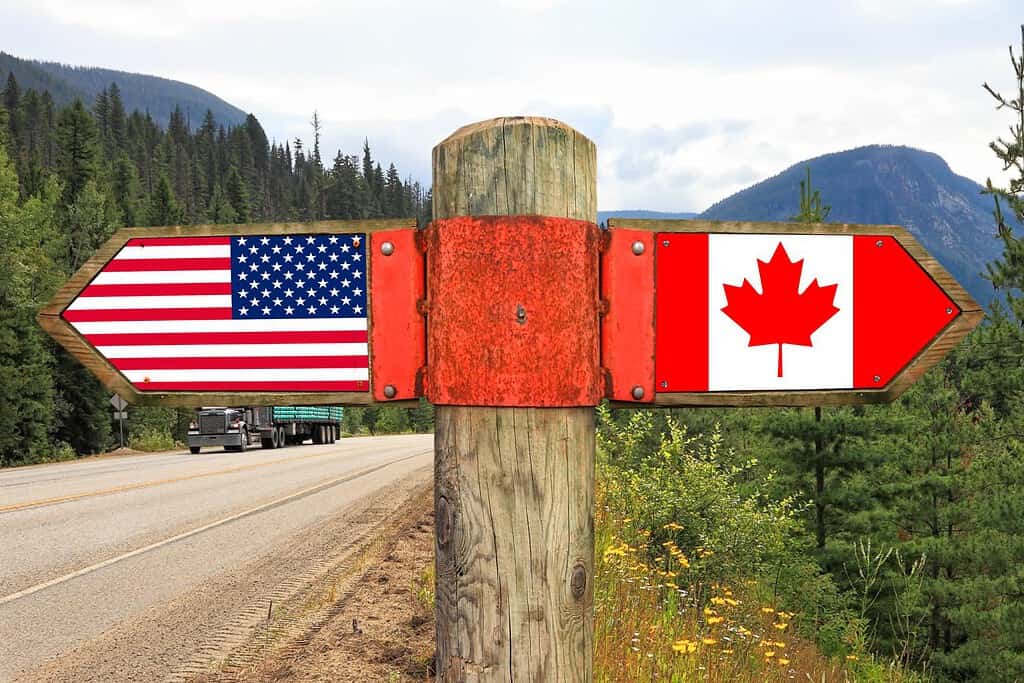Canada and the United States are so similar culturally that some people ask why they don’t join into one country. This doesn’t take into account their unique histories and cultures or the high costs and questionable benefits of merging. Let’s look into why they haven’t merged, and whether they might merge in the future.
They Were United, Sort of

The U.S. and Canada were united under the British government for about 20 years.
©I. Pilon/Shutterstock.com
British settlement of North America started in Virginia and expanded into 13 separate colonies. France colonized Canada but lost the area to Britain in the 1763 settlement of the French and Indian War. For the next 20 years, what would become the United States and Canada were united under British rule.
Different Attitudes Toward the Motherland

Nova Scotia was one of the Canadian colonies that welcomed loyalists fleeing the American Revolution.
©Shomr-Li-at/Shutterstock.com
By 1776, the 13 colonies had been under British rule for about 200 years and had a population of over a million. They resented not having representation in the government and a say in taxation policies and were ready to revolt.
By contrast, the population of Canada in 1775 was only about 90,000 and had been under British rule for only 20 years. There was little appetite for war among recently defeated Francophones and their Native American allies, nor the small minority of English speakers.
Moreover, thousands of loyalists fled the American colonies to Canada, and another 45,000 or so evacuated there at the end of the Revolution. They were certainly not interested in seeing their new homelands annexed to the very country they had opposed.
The U.S. Invaded Canada Twice

The modern Quebec City skyline features the iconic Chateau Frontenac.
©Songquan Deng/iStock via Getty Images
In 1775, the Continental Army invaded Quebec. They hoped the Québécois would join them and revolt against the British, but they didn’t take the bait. The Quebec Act of 1774 acknowledged Francophones’ right to keep their language and culture, as well as adding what is today Ohio, Indiana, Illinois, Michigan, Wisconsin, and Minnesota to Quebec. These concessions helped win Quebec’s cooperation with the British government.
Round two came in the War of 1812. After naval tensions erupted into war with Britain, American troops made several failed attempts to capture southern Ontario. Canada’s successful defense helped solidify its identity as a completely separate country.
Canada’s Gain, Mexico’s Loss

Seattle, Washington was one of the areas in sharp dispute between the United States and Britain.
©Edmund Lowe Photography/Shutterstock.com
In 1841, Britain combined their Canadian territories into the Province of Canada. The border in the Oregon Country was still in such sharp dispute that many thought it would lead to a third Anglo-American war. Although many in the U.S. wanted to take all of British Columbia, they compromised and divided the area at the 49th parallel. This freed them to focus on a war with Mexico that settled the border of Texas and allowed the U.S. to seize about 55% of Mexico’s territory, including California.
Modern Developments
With the most serious border issues settled, the United States developed an increasingly warm relationship with both Canada and Great Britain. This was cemented when they were allies in both World Wars and became NATO allies in the Cold War. Today, the U.S. and Canada enjoy the longest undefended border in the world. Since 1988 they have had a free trade agreement that expanded to include Mexico in 1994. Both are in the top three of each other’s main trading partners.
Arguments For Merger

A united North America could make it easier for the population of over-crowded American cities.
©Viacheslav Lopatin/Shutterstock.com
Things seem to be going pretty well in the U.S.-Canada relationship. What would be accomplished by merging the two countries?
- Prosperity: removing international borders, lifting trade restrictions, using a common currency, and standardizing regulations would give both sides an economic boost.
- Development: Canada’s untapped natural resources would be more available for development by U.S. investors. The whole continent could be more self-sufficient.
- Defense: There would be no impediments to military movements across the continent and more resources would be available to defend the vulnerable, rapidly thawing Arctic.
- Migration: Without an immigration process, the population could shift more easily from overcrowded areas of the U.S. to underpopulated areas of Canada.
However, everything we could gain from a merger could also be gained through treaties to create more integration between the two countries without merging them under one government.
Arguments Against Merger

The priority to the French language in Quebec could come to an end if Canada and the U.S. merged.
©WorldStock/Shutterstock.com
What are some of the problems of merging?
- Loss of Culture: Canada uses the metric system and has popular social programs like universal healthcare. The United States has permissive laws on gun control, less business regulation, and a more assertive foreign policy. Each side would have to make some compromises to create a common national policy on a whole host of issues.
- Indigenous Rights: First Nations people and the Québécois might lose the special rights that preserve their cultures and help keep Canada united.
- An Unequal Union: With a population as large as California, Canada would have a decisive influence in national elections. However, with only a 10th of the U.S. population, Canada would be the junior partner and would have to bear the lion’s share of difficult social and political changes.
- Expense: It would take billions of dollars to print more money, change signs and logos, retrain public officials in unfamiliar new regulations, issue new passports, convert to the metric system, and change thousands of things, large and small, to one national standard.
Is Disunity the Route to Unity?

The only way the United States would join Canada would be a collapse of the federal government.
©karen roach/Shutterstock.com
“Can’t-ada”
The Canadian province of Quebec has held two referenda on independence but neither succeeded. If Quebec were to split off, the Maritime provinces would be isolated from the rest of the country and might have an interest in becoming U.S. states. 90% of Canadians live within 100 miles of the U.S. border. Some people in western Canada feel more aligned with nearby American states than with their government in Ottawa. If Canada were splitting up, British Columbia and other western provinces might find statehood appealing.
“The Disunited States of America”
In the U.S. there’s always talk in some states about declaring independence: usually California or Texas. That didn’t work out so well for the Confederacy during the Civil War, so it’s not a serious proposal for anyone but a handful of enthusiasts. However, suppose deep political divisions or a massive natural disaster caused a collapse of the Federal government. In that case, some of the states might find it attractive to become provinces of Canada. New England, Alaska, Minnesota, and the Pacific Northwest are some areas that border Canada and might politically be the most compatible of the American states to Canada’s culture and social system.
Unity in Diversity

Two countries working in harmony while respecting one another’s independence is a model for the world.
©Protasov AN/Shutterstock.com
Canada and the United States have a good thing going. Merging them into one country would do more harm than good. Both sides can work together to standardize laws and regulations. At the same time, they can maintain their independence and the cultural differences that make them great countries. This unity in diversity can be a model for the whole world.
The photo featured at the top of this post is © ilolab/Shutterstock.com
Thank you for reading! Have some feedback for us? Contact the AZ Animals editorial team.







